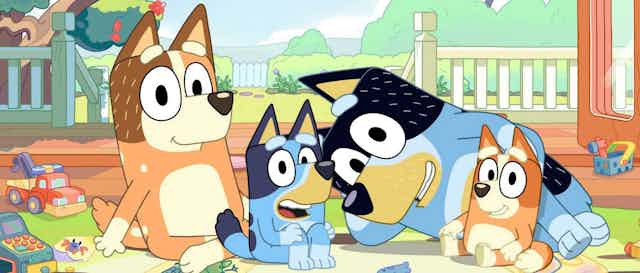Bluey is easily the most successful Australian television show of the last decade. A record-breaking success for its local broadcaster the ABC, as well as production partners BBC Studios and Screen Australia, Bluey now has a global stage via Disney.
There are many factors behind Bluey’s success, including beautiful animation, nuanced storytelling, and insightful reflections of family life. One element that is integral but not spoken about enough is the show’s music.

Many children’s programs approach music and sound with a directness and lack of complication — think Play School’s wonderfully simple piano.
Bluey is distinct because it sounds rich and intertextual. Finally, fans of the Bluey sound can appreciate it fully, with the soundtrack released today.
Composer Joff Bush and his colleagues have created a world of original and repurposed works that develop characters, plot and narrative across episodes. The music, like the visuals, provides hooks to keep audiences of all ages engaged.
Here are three musical signatures to listen for:
1. The opening theme
The best television themes of any genre set the mood and expectation of the show, as well as introducing the characters. In this case, the tune literally tells us who’s coming, singing “Mum! Dad! Bluey! Bingo!” along with the characters on screen.
Bush’s musical economy is brilliant, immediately setting the mood for the show. The theme instantly indicates something childlike with the melodica, an instrument second only to the recorder in the way it recalls primary school music rooms. The melody dances up and down the scale as the show’s characters dance on screen, punctuated with the delightful roll call of names and the show’s title.
Read more: TV's top ten ear worms, from a television tragic
The new soundtrack album features three versions of the show’s opening theme tune, including an extended version and an instrument parade, adding a list of instruments for listeners to respond to. After “Mum!, Dad! Bingo! Bluey!” come new calls, like “violins!” and “trumpet!”.
2. Character themes
In an early episode, Grannies, Bluey and Bingo dress up as grannies “Rita” and “Janet” to keep themselves amused while their parents complete household chores.
With Bush’s character theme for the girls’ dress ups, the episode becomes something more than a story of play and distraction. The music is catchy, but also cheeky and a bit naughty, setting up the episode to sound more like a mainstream sitcom than a children’s show.
The Grannies theme works in short sharp bursts throughout the episode, similar to American sitcom soundtracks — like the quirky wonderfulness David Schwartz brought to Arrested Development (2003-19) — and the unusual (and funny) tempo and instrument combinations used by Ronny Hazelhurst BBC comedies like Some Mothers Do ‘Ave 'Em (1973-78) and The Two Ronnies (1971-87).
Throughout the series, Bush’s music isn’t simply used as colour. Instead, Bluey uses music to advance story, place and character. The grannies theme comes and goes as Bluey and Bingo move in and out of their fantasy world, and returns in a later episode where the girls play the game again.
Using the soundtrack in this way rewards adult viewers who know this screen soundtrack recall technique: the Imperial March is sonic shorthand for everything Darth Vader; Isobel Waller-Bridge’s choral theme for the Priest in season two of Fleabag (2016-19).
Read more: 'Making up games is more important than you think': why Bluey is a font of parenting wisdom
3. Classical references
Bluey’s season two finale, Sleepytime, was named by the New York Times as one of the Best Television Episodes of 2020.
Mum puts little sister Bingo to bed by reading a bedtime story about space, followed by a dream sequence where the solar system story comes to life.
In this episode, Bush uses Gustav Holst’s Jupiter as the main theme. The music instantly takes us out of the normal Bluey world, supporting the visuals as Bingo leaves earth, too.
The scale of the orchestrated sounds reflects the scale of the story of the child and parenting learning to leave each other at night. The soundtrack also serves a musical joke — what sounds like the solar system but Holst?
Other episodes also use existing music in nuanced ways. Ice Cream references Fantasia with a hilarious appearance of Tchaikovsky’s Waltz of the Flowers as the girls twirl around dripping ice cream cones; Fancy Restaurant uses Vivaldi’s Spring for atmosphere as the girls create a well-meaning (but doomed) date night for their parents; The Magic Xylophone uses Mozart’s Ronda Alla Turca for a game of musical statues.
Much of Bluey’s success is in the way it is designed for children and adults watching together. In Bush’s composition, children are given original and iconic music that satisfies story and character in a way that is new to them, while older viewers are given musical reminders of a variety cultural favourites from television and film.
Of course, the genius of Bluey is that all audiences can pick up any of the musical clues at any time, with repeat viewing revealing more and more.

